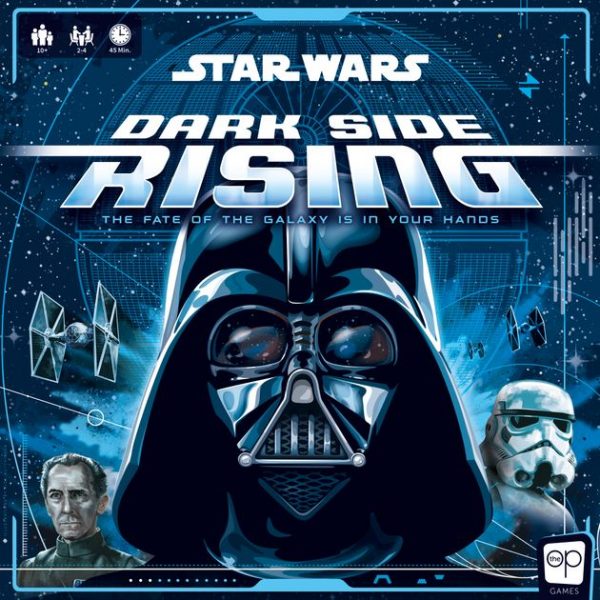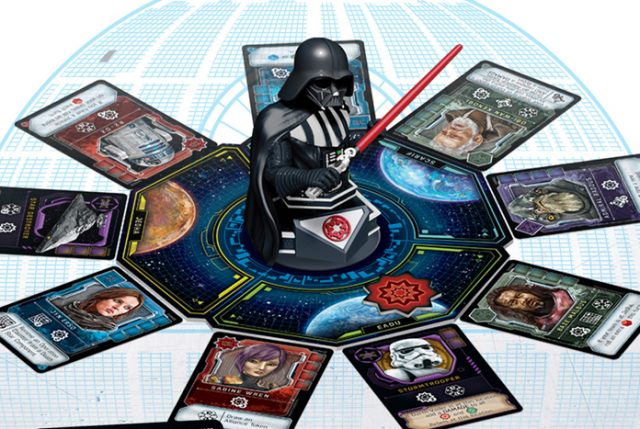
There have been some incredibly cool Star Wars tabletop games in recent years, which have mostly had one thing in common – they’re incredibly complex and tough to get to grips with. So what if I told you that Dark Side rising is not only an accessible, easy to learn game but one that actually very decent? I know, I was surprised too.
The Death Star is being built still (obviously), with six components nearing completion. The objective of the players is to slow down these components as much as possible while trying to fulfil the single success objective of defeating a certain number of enemies. This is done by building up your team using characters from the “original” Star Wars films and defeating Imperial bad guys across various sectors, all the while trying to make sure none of the three defeat conditions are met under the watch of a surprisingly intimidating Darth Vader model, perched atop the Death Star. If it sounds like the odds are stacked against you a bit, that’s because they are. But you know the drill, never tell me the odds.
The game is strongly co-op based, and needs good teamwork to make sure you keep an eye on those conditions while still building up your own side of things. Your turn will start by choosing one of the three sectors positioned around Vader on the central board. Choosing the right sector for that turn is an increasingly important step, given that it limits you to which characters and assets you can use and determines which enemies you’ll be up against. Before you can do anything else, you’ve got two dice to roll. The first determines which component of the Death Star will make some progress towards being operational. If you complete the component, the tile is flipped and that section is ready to go. If you roll that one again on a later turn, then it activates and provides additional bonuses for the enemies nearby which, as you can imagine, isn’t ideal. It brings the random nature of the dice into the game which, I’m sure, will irritate some, but I found it worked really well and gave some brilliant tension to these rolls, especially later in the game when more parts of the Death Star are being completed and ready to activate.

The same works on the next dice, which gives you an action of Vader himself. This dice determines whether Vader turns to the left, right, or stays where he is. If a player is in the sector he ends up facing, they’ll take damage. If they decided to enter the sector he was already in, and the dice roll keeps him in the same place, then he won’t just attack the players but will also either activate every other Imperial bad guy to carry out their own attacks or abilities. The alternative, depending on the dice roll, is for the Death Star to get another dice roll, therefore nudging another component closer to completion. Eek. Time to fight back!
The Rebel dice rolls allow you to decide what you’re going to try and do to progress your own efforts. Each turn will essentially allow you to try and recruit another Rebel into your team, or deal out some damage to an Imperial character. Different cards have different symbols which show you what you need the dice to land on in order to recruit or damage them; if you’re successful in doing what you’re trying to do then the card is either added to your collection (in the case of the Rebels, where they’ll provide additional dice or abilities) or removed completely when defeated. Either way, a new card is drawn to replace them and the game moves on. You’re trying to defeat a certain number of Imperials (7 out of the 11 in the deck, for an easy game) before the whole Death Star becomes operational, you have ten Rebels defeated overall or any player loses all of their Rebels. It’s a lot to keep an eye on, but nothing devastatingly complicated – it’s essentially a loop of dice rolls and decisions, leading up to you either kicking Vader’s ass and winning, or seeing your hard work slip away when the Death Star wakes up and obliterates you from existence. It’s a harsh galaxy.
As I mentioned earlier, the dice rolls give things a random twist, especially with the Death Star and Vader dice, but given how much strategy can be applied to the Rebel dice rolls it seems quite balanced to me. It helps to keep the game ticking along at a pretty decent pace, and given that my 7 year old managed to join in a game despite never having seen Star Wars and needing a bit of help on the strategy side, it’s a genuine family game that can be enjoyed by a good range of people. It’s easy to learn, easy to remember, and doesn’t take much more than 30 minutes or so to play.
An easy one to recommend to Star Wars fans, that’s for sure.
This game was provided for unbiased review by Asmodee UK.

Leave a Reply